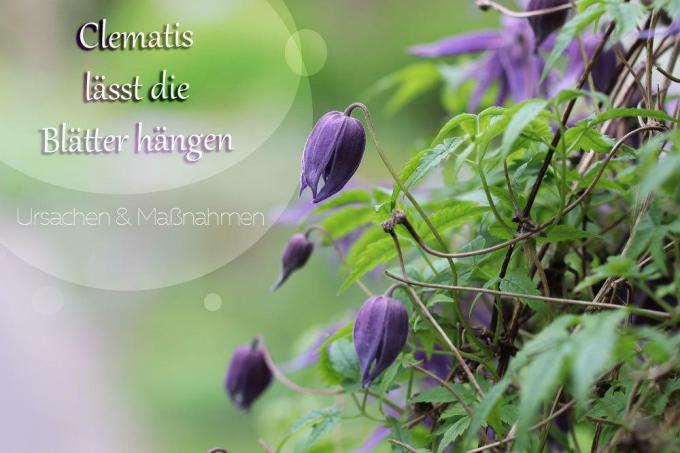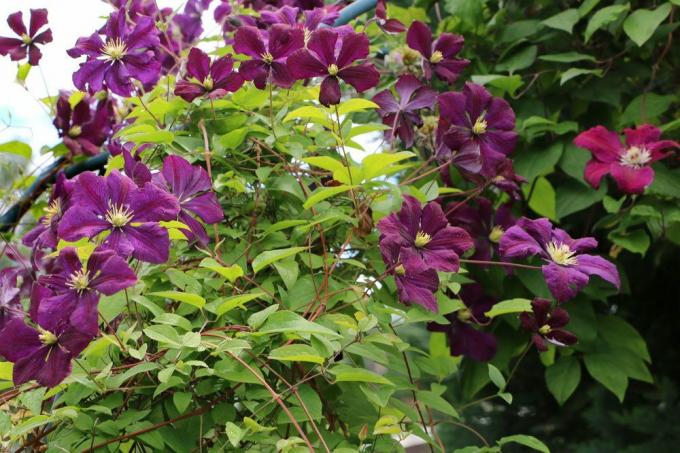
table of contents
- causes
- Lack of water
- Feet too warm
- Kinked shoots
- Clematis wilt
- 1. Phoma clematis wilt
- 2. Fusarium wilt
The clematis is one of the most popular climbing plants for the garden and is often called the "queen of the." Climbing plants" designated. Actually it is Clematis very easy to care for. In addition to a partially shaded location, it only needs occasional fertilization and watering. If the clematis suddenly drops its leaves, something is wrong. Now is the time to check carefully!
causes
The reasons for the withered leaves can be very different and from simple dryness to the dreaded Clematis wilt are sufficient. The first step is to examine the plant in detail. The current weather situation can serve as a first indication. Has it been damp and rainy for a long time or rather hot and dry? In both cases there are different causes for the hanging clematis leaves.
Lack of water
Maybe the pretty climbing plant just has to be watered? A good water supply is important for the clematis to thrive perfectly. Because a sufficiently supplied plant is particularly resilient. In general, clematis are very thirsty plants that need regular watering. This is particularly important in spring and summer. When watering, only the soil around the roots is wetted, as moisture on the shoots and leaves promotes the spread of fungi. If the clematis lacks moisture, the entire foliage usually hangs down. In individual cases, however, only the shoots lying in the sun are affected.
tip: Dig a small hollow near the roots with your finger. If the soil is bone dry even at a depth of ten centimeters, the plant probably only needs water.
Feet too warm
Since the wild forms of the clematis live in forests, they feel most comfortable under similar conditions. In practice this means:
- shady on the ground
- further up sunny
If the blazing sun shines on the roots for too long, clematis usually respond with withered leaves. You should therefore cover the floor area with mulch or stones or a flat one Ground cover plants that provide shade and cool roots. Often the soil is too dry at the same time, so that the plant should be watered carefully afterwards.
tip: When planting ground cover, make sure that these do not develop pronounced roots that would then compete with the clematis.
Kinked shoots
The filigree flowering plant should generally only be planted in protected locations where the air can still circulate well. In unfavorable locations in the garden, the delicate shoots can easily snap off in strong winds or a storm with storms and hail. If the leaves only hang down on one side or certain shoots of the clematis, it is likely that one or Several shoots have suffered mechanical damage and the water and nutrient supply in the ducts is interrupted became. This leads to wilting and death of the affected region and is initially expressed in the fact that the leaves hang down limply. Examine your climbing plant very carefully for breaks or injuries. The dying shoots are not only unsightly, but pathogens such as fungi, viruses and bacteria can also penetrate the plant through the wounds and damage it irrevocably.
First aid measures:
- Cut the shoot below the break
- use clean, sharp tools
Clematis wilt
If all of the above-mentioned causes of hanging leaves on the clematis have been ruled out, you must assume that the clematis is infested with the dreaded clematis wilt. The disease can really spoil the pleasure of a hobby gardener in a spectacular play of colors in the garden. Because if the clematis is infested, it dies to the ground within a short time. However, what very few people know is that clematis wilt are actually two different diseases. Both diseases are caused by Fungal pathogens causes, but take a very different course. Infection is favored by excessive moisture in the soil or warm and humid conditions such as fog or long periods of rain. Illness is therefore possible despite the best care.
1. Phoma clematis wilt
The more common form of wilt is the Phoma clematis wilt. It is caused by a fungus called Ascochyta clematidina. The fungus also spreads to stems and shoots. If the weather is warm and humid, entire shoots will wither within two weeks. In general, every clematis can be affected, but the fungal pathogen leads to the complete death of the above-ground shoots, especially in large-flowered hybrids of the clematis. It is important that you recognize the Phoma clematis wilt in good time. Because once the fungus has reached the inside of the shoot, the infection progresses quickly and can hardly be stopped.
Signs
- Time: early summer
- small light brown spots on the leaves
- yellowish court
- first on the underside of the leaves in the lower area
- Spots get bigger and darker
- Death of the entire leaf
First aid measures
- Check regularly from May onwards
- remove infected leaves
- Treat with a commercially available fungicide
Is the wilting of the clematis already advanced and the leaves drooping or drooping have died, the only thing that helps is an immediate, radical cut back to just above that Ground level. Fortunately, almost all clematis that have been pruned so vigorously recover completely. However, they need time to do so.
Tip: Some plants do not sprout again until the second year. So be patient and continue to care for the clematis as usual.
2. Fusarium wilt
Fusarium clematis wilt is caused by another fungal pathogen: Coniothyrium clematidis-rectae. It occurs much less often than the Phoma clematis wilt and only affects the large-flowered hybrids of the clematis. The fungus penetrates the inside of the plant through wounds and clogs the pathways of the climbing plant. Such injuries often result from mechanical damage or large temperature fluctuations in the winter months. Since no more water and nutrients can get into the shoots and leaves due to the blocked pipes, the affected parts of the plant die off.
Signs
- Time: from mid-June (mushroom needs high temperatures)
- sudden withering of entire shoot parts
- no stains on the leaves (as with Phoma-wilt)
- instead: brown discoloration from the edge
First aid measures
- immediate radical cut back
- down to floor level
- no control possible
- Dispose of infected parts of the plant in household waste
Here, too, the chances are good that the clematis will recover from the wilt. The fungus primarily damages the above-ground shoots.



